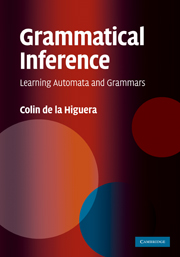Book contents
- Frontmatter
- Contents
- Preface
- Acknowledgements
- 1 Introduction
- 2 The data and some applications
- Part I The Tools
- Part II What Does Learning a Language Mean?
- Part III Learning Algorithms and Techniques
- 11 Text learners
- 12 Informed learners
- 13 Learning with queries
- 14 Artificial intelligence techniques
- 15 Learning context-free grammars
- 16 Learning probabilistic finite automata
- 17 Estimating the probabilities
- 18 Learning transducers
- 19 A very small conclusion
- References
- Index
17 - Estimating the probabilities
from Part III - Learning Algorithms and Techniques
Published online by Cambridge University Press: 05 July 2014
- Frontmatter
- Contents
- Preface
- Acknowledgements
- 1 Introduction
- 2 The data and some applications
- Part I The Tools
- Part II What Does Learning a Language Mean?
- Part III Learning Algorithms and Techniques
- 11 Text learners
- 12 Informed learners
- 13 Learning with queries
- 14 Artificial intelligence techniques
- 15 Learning context-free grammars
- 16 Learning probabilistic finite automata
- 17 Estimating the probabilities
- 18 Learning transducers
- 19 A very small conclusion
- References
- Index
Summary
We cannot seriously propose that a child learns the values of 109 parameters in a childhood lasting only 108 seconds.
George A. Miller and Noam Chomsky (Miller & Chomsky, 1963).Par exemple, il arrive qu'après les douze chiffres du milieu sortent les douze derniers chiffres; deux fois, mettons, le coup porte sur ces douze derniers chiffres et passe aux douze premiers. Une fois qu'il est tombé sur les douze premiers, il revient sur les douze du milieu; trois, quatre fois de suite, les chiffres du milieu sortent, puis ce sont de nouveau les douze derniers; après deux tours, on retombe sur les premiers, qui ne sortent qu'une fois, et les chiffres du milieu sortent trois fois de suite; cela continue ainsi pendant une heure et demie ou deux heures. Un, trois et deux; un, trois et deux. C'est très curieux.
Fedor Dostoïevski, Le joueur.Let us suppose we are given a sample and an automaton. By automaton we mean the structure or at least some constraints on the number of states and some restrictive syntactical conditions on the transitions we are allowed to use. We are interested in finding a systematic way of converting the automaton into a probabilistic generator such as those we studied in Chapter 5. It would also be interesting to be able to do something similar for grammars instead of automata.
- Type
- Chapter
- Information
- Grammatical InferenceLearning Automata and Grammars, pp. 357 - 371Publisher: Cambridge University PressPrint publication year: 2010



